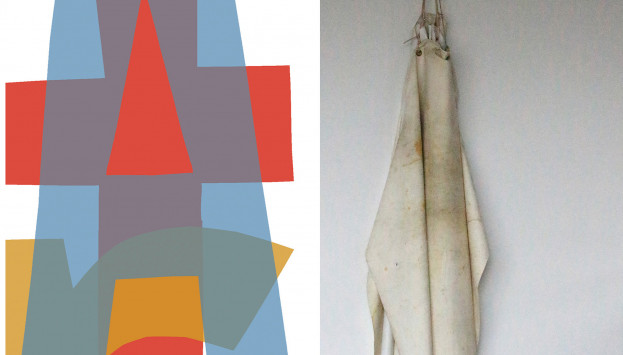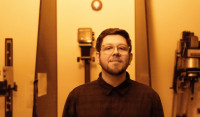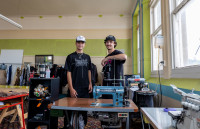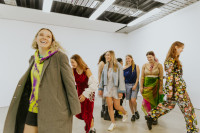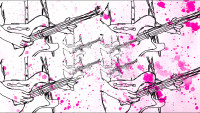Dunedin School of Art Lunchtime Research Seminar Schedule Term 1, 2019
Dunedin School of Art Lunchtime Research Seminar Schedule Term 1, 2019
THUR 28 FEB, 12.00 – 1.00 PM, P152 LECTURE ROOM, DUNEDIN SCHOOL OF ART, RIEGO ST.
Kevin Fisher
Post-cinematic Ontology and the Reversibility of the Flesh
In this presentation I argue that theorizations of the ontology of cinema reproduce what Heidegger describes as the tendency of Western metaphysics to mistake “ontic” questions about the objective existence of beings for properly “ontological” questions which concern the possibility for reflexive Being, or Dasein. My critique applies equally to accounts of analog and digital cinema insofar as both privilege determinations of ontology on the basis of the materiality or immateriality of the medial substrate. Instead, I propose that the conditions of ontology set forth by Heidegger are more fully realised in the cinema’s ability to enact the chiasmatic reversibility of subject and object in what Merleau-Ponty describes as the flesh of the world. I will show how, within the context of Sobchack’s description of film’s body, the chiasm of this reversibility is activated around the hinge of the cut and through the formal devices associated with it. As such, my approach reverses the longstanding association of ontology with the profilmic qualities of the indexical image, and disengages it from traditional understandings of media specificity. I’ll also suggest how this argument extends a minority position within film studies, which describes cinema ontology as a product of movement rather than representation.
Dr Kevin Fisher is a Senior Lecturer in Media Film and Communication at the University of Otago. His research interests include film theory, phenomenology, documentary and genre studies.
___________________________________________________________________________
THUR 7 MARCH, 12.00 – 1.00 PM, P152 LECTURE ROOM, DUNEDIN SCHOOL OF ART, RIEGO ST.
Caroline McQuarrie
Mining Histories: West Coast Projects
Since 2011 Caroline McQuarrie has been engaging with the history of the West Coast region, exploring what it meant for 19th and early 20th century settlers to make a home in a region which was physically difficult, and previously occupied. Employing photography as a primary medium, but augmenting it with embroidery, weaving and video, McQuarrie has explored abandoned mining towns, deep marks left on the landscape by mining, and heroic colonial journeys. In this seminar she will discuss her projects No Town, Homewardbounder, Waiuta and Prospects Fearful, and the difficulties for an artist engaging colonial histories in a post-colonial country.
Caroline McQuarrie is an interdisciplinary artist whose primary interest is the concept of home, whether it is located in a domestic space, a community or the land we identify with. She works with photography, video and craft practices to explore meaning carried in photographic and craft based objects and domestic, suburban or community sites. Her work explores how the photographic representation of a site with a particular history can reflect on the present. Caroline is a Lecturer in Photography at Whiti o Rehua School of Art, College of Creative Arts, Massey University, Wellington, New Zealand.
___________________________________________________________________________
THUR 28 FEB, 12.00 – 1.00 PM, P152 LECTURE ROOM, DUNEDIN SCHOOL OF ART, RIEGO ST.
Yvonne Shaw
The Residual: Photography, Kristeva and the Unconscious
A type of transference takes place in the staging of a photograph. Tensions that are evoked by proximity to others and by the presence of the camera are communicated via gesture and expression. By drawing attention to interiority and ambiguity, Yvonne Shaw illuminates these unconscious tensions within her photographic series The Residual. Informed by Julia Kristeva's theories of alterity and Sigmund Freud's writings on the unconscious, The Residual presents moments that hover between staged fiction and the authentic awkwardness of strangers encountering each other.
"It is through unraveling transference ... that, on the basis of the other, I become reconciled with my own othernessforeignness,
that I play on it and live by it." -Julia Kristeva, Strangers to Ourselves
Yvonne Shaw is an Auckland-based artist who uses photographic portraiture to explore psychological relations between people. Situating models in various urban locations she constructs images that evoke the complex tensions of social encounters. She has an MFA with First Class Honours from Elam School of Fine Arts. Her photographs and photobooks have been exhibited in New Zealand and Australia. In 2018 she was awarded the Second Runnerup Award in the 27th Annual Wallace Art Awards.
__________________________________________________________________________
THUR 21 MARCH, 12.00 – 1.00 PM, P152 LECTURE ROOM, DUNEDIN SCHOOL OF ART, RIEGO ST.
Areta Wilkinson + Mark Adams (a collaboration)
Repatriation
The situation of the artifact and Ng¯ai Tahu taonga from Te Waipounamu – The South Island, within museums in Aotearoa and abroad is foregrounded in the collaborative project of M¯aori artist Areta Wilkinson (Ng¯ai Tahu) and P¯akeh¯a artist Mark Adams. A residency at the Museum of Archaeology and Anthropology at Cambridge University, UK between 2009-17 allowed the artists to respond to those parts of collections with personal significance housed in English and German imperial museums. The pair produced unique silver bromide photograms of taonga and the tools and materials of their making. For Wilkinson, the project allowed a direct engagement with her whakapapa as a maker, and to produce new works from the absences in these photograms which directly reference the m¯atauranga M¯aori of her ancestors. For Adams, the project opened a way of engaging with the colonial relationships these artifacts and taonga are enmeshed in without messing with them. Repatriation return the shades of this cultural material and new manifestations of it to our eyes here.
Mark Adams is one of New Zealand’s most distinguished photographic artists. He was born in Christchurch, and attended University of Canterbury School of Fine Arts from 1967 to 1970. He subsequently became well known for work concerned with cross-cultural interactions around Rotorua, Samoan tatau (tattooing) among the diaspora in New Zealand, the voyages of Captain Cook and other dimensions of colonial history in New Zealand, elsewhere in the Pacific, and in Europe. His work has been exhibited at biennales in Sao Paulo and Johannesburg, and otherwise in countries including Australia, Britain, Canada, the Netherlands and New Zealand.
Areta Wilkinson is an artist of Ng¯ai Tahu descent, a M¯aori tribal group of Te Waipounamu the South Island of New Zealand. Wilkinson has investigated the intersection of contemporary jewellery as a form of applied knowledge and practice with M¯aori philosophies, especially whakapapa (genealogies) and a worldview informed by Ng¯ai Tahu perspectives. These ideas are articulated in her 2014 PhD Creative Arts with Massey University. Wilkinson’s work is seen in New Zealand public collections and current artworks are exhibited in the 9th Asia Pacific Triennial of Contemporary Art (APT9) at Queensland Art Gallery Museum of Modern Art (QAGOMA).
___________________________________________________________________________
THUR 28 MARCH, 12.00 – 1.00 PM, P152 LECTURE ROOM, DUNEDIN SCHOOL OF ART, RIEGO ST.
Paul Brobbel
Pretty good, for the 21st Century
Len Lye’s claim that his work will be ‘pretty good, for the 21st century’ was a witty but prescient exclamation made in the 1960s at the peak of his career as a kinetic artist. In relation to this notion of the future, curator Paul Brobbel will reflect upon posthumous activities and exhibition making of Lye’s work at the Govett-Brewster Art Gallery. He will introduce the various concepts at play at the Len Lye Centre, looking closely at the unique opportunities and challenges in building an internationally recognised programme around a single artist in provincial Aotearoa.
Paul Brobbel is Senior Curator and Len Lye Curator at the Govett-Brewster Art Gallery / Len Lye Centre. In 2016 he was a Research Fellow at the Henry Moore Institute in Leeds. Paul has worked at museums throughout Aotearoa New Zealand, including the Museum of New Zealand Te Papa Tongarewa, Auckland Museum and Puke Ariki. He has written extensively on the work of Len Lye including recent publications with the Getty Conservation Institute and Canterbury University Press.
___________________________________________________________________________
THUR 4 APRIL, 12.00 – 1.00 PM, P152 LECTURE ROOM, DUNEDIN SCHOOL OF ART, RIEGO ST.
Ed Hanfling
You Can Never Have Too Much of a Good Thing
Taking in the First Church and functionalism, fandom and feminism, formalism and fragmentation, and other “f” words, Ed reflects on what he learned from writing a book and curating an exhibition on the art and design of contemporary modernist Roy Good.
Ed Hanfling is an art historian, critic and curator who teaches art history and theory at the Dunedin School of Art. His book Parallel Universe: The Art and Design of Roy Good was published in December 2018, and he curated an exhibition of the same title for Te Uru Waitakere Contemporary Gallery and Christchurch’s Centre of Contemporary Art.
___________________________________________________________________________
THUR 11 APRIL, 12.00 – 1.00 PM, P152 LECTURE ROOM, DUNEDIN SCHOOL OF ART, RIEGO ST.
Susan Best
Intimacy with Strangers: Nat Randall and Anna Breckon's The Second Woman
This paper examines one contemporary participatory performance that centres on a romantic couple: a twenty-four hour performance work by Anna Breckon and Nat Randall called The Second Woman (2016). This work uses the serial method established by conceptual art as an impersonal mode to present 100 intimate encounters between Nat Randall and the various men who answered a call out to participate. The work repeats a scene between a woman and her lover where disconnection and repair figure. The men are at once highly individual and yet also interchangeable, disposable and substitutable (like a contemporary Tinder dating app, the men slide past quickly into a blur). Randall has an astonishing capacity to accommodate each man and his approach to the narrative and the performance, I analyse her approach to seriality using the idea of "the law of the mother" developed by British psychoanalyst Juliet Mitchell.
Susan Best is an art historian and occasional curator, specialising in modern and contemporary art. Her books include Visualizing Feeling: Affect and the Feminine Avant-garde (2011) and Reparative Aesthetics: Witnessing in Contemporary Art Photography (2016). Both books won the Australia and New Zealand Art Association best book prize. She is a fellow of the Australian Academy of the Humanities.
___________________________________________________________________________
Published on 7 Mar 2019
Orderdate: 7 Mar 2019
Expiry: 18 Apr 2019
